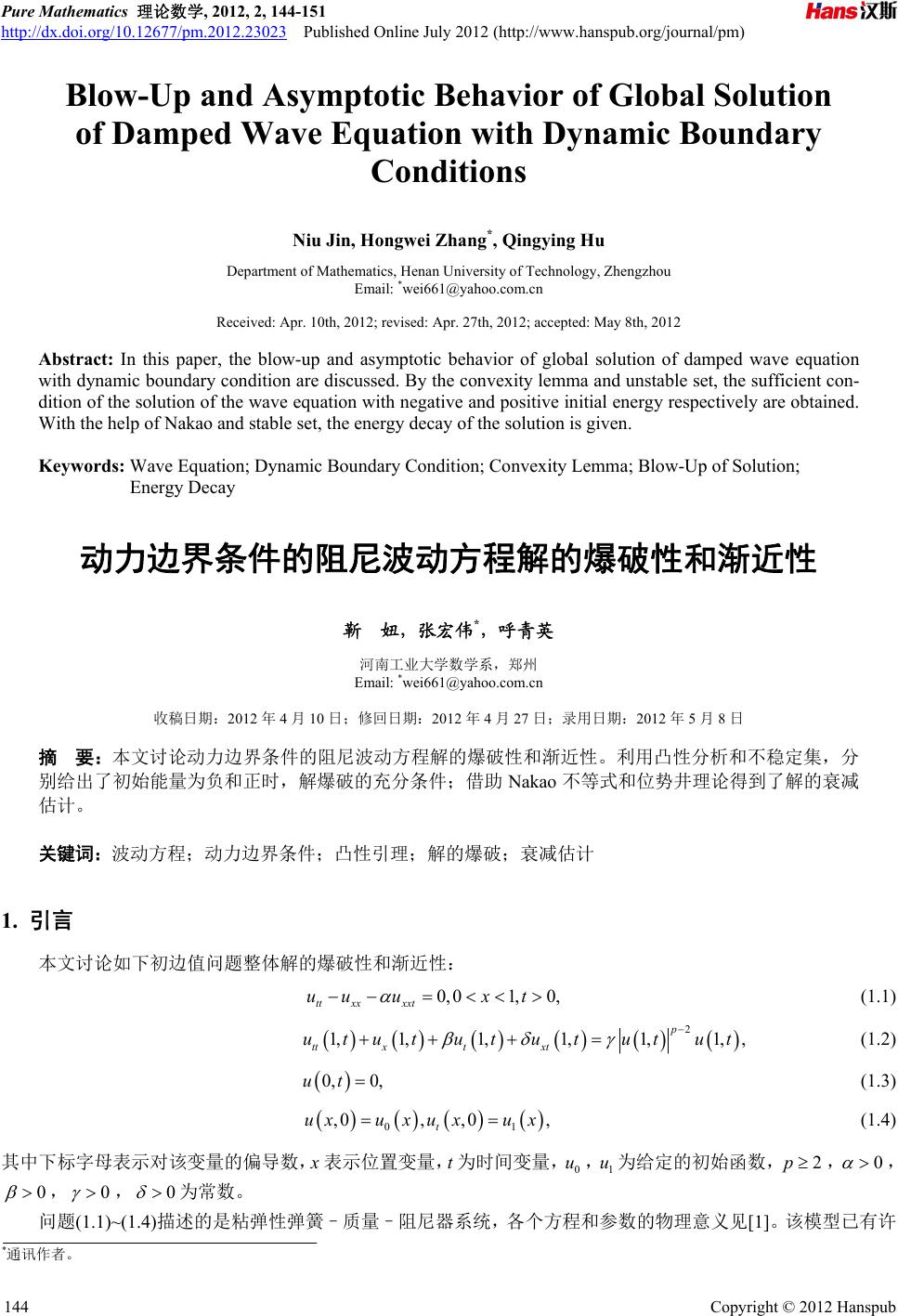 Pure Mathematics 理论数学, 2012, 2, 144-151 http://dx.doi.org/10.12677/pm.2012.23023 Published Online July 2012 (http://www.hanspub.org/journal/pm) Blow-Up and Asymptotic Behavior of Global Solution of Damped Wave Equation with Dynamic Boundary Conditions Niu Jin, Hongwei Zhang*, Qingying Hu Department of Mathematics, Henan University of Technology, Zhengzhou Email: *wei661@yahoo.com.cn Received: Apr. 10th, 2012; revised: Apr. 27th, 2012; accepted: May 8th, 2012 Abstract: In this paper, the blow-up and asymptotic behavior of global solution of damped wave equation with dynamic boundary condition are discussed. By the convexity lemma and unstable set, the sufficient con- dition of the solutio n of the wave equation with n egative and positive initial en ergy respectively are obtain ed. With the help of Nakao and stable set, the energy decay of the solution is given. Keywords: Wave Equation; Dynamic Boundary Condition; Convexity Lemma; Blow -Up of Solution; Energy Decay 动力边界条件的阻尼波动方程解的爆破性和渐近性 靳 妞,张宏伟*,呼青英 河南工业大学数学系,郑州 Email: *wei661@yahoo.com.cn 收稿日期:2012 年4月10 日;修回日期:2012 年4月27 日;录用日期:2012 年5月8日 摘 要:本文讨论动力边界条件的阻尼波动方程解的爆破性和渐近性。利用凸性分析和不稳定集,分 别给出了初始能量为负和正时,解爆破的充分条件;借助 Nakao 不等式和位势井理论得到了解的衰减 估计。 关键词:波动方程;动力边界条件;凸性引理;解的爆破;衰减估计 1. 引言 本文讨论如下初边值问题整体解的爆破性和渐近性: 0,01, 0, tt xxxxt uuux t (1.1) 2 1,1, 1,1, 1,1,, p tt xtxt ututu tututut (1.2) 0, 0,ut (1.3) 0 ,0, ,0, t ux uxuxux 1 (1.4) 其中下标字母表示对该变量的偏导数,x表示位置变量,t为时间变量,, 为给定的初始函数,, 0 u1 u2p0 , 0 ,0 ,0 为常数。 问题(1.1)~(1.4)描述的是粘弹性弹簧–质量–阻尼器系统,各个方程和参数的物理意义见[1]。该模型已有许 *通讯作者。 Copyright © 2012 Hanspub 144 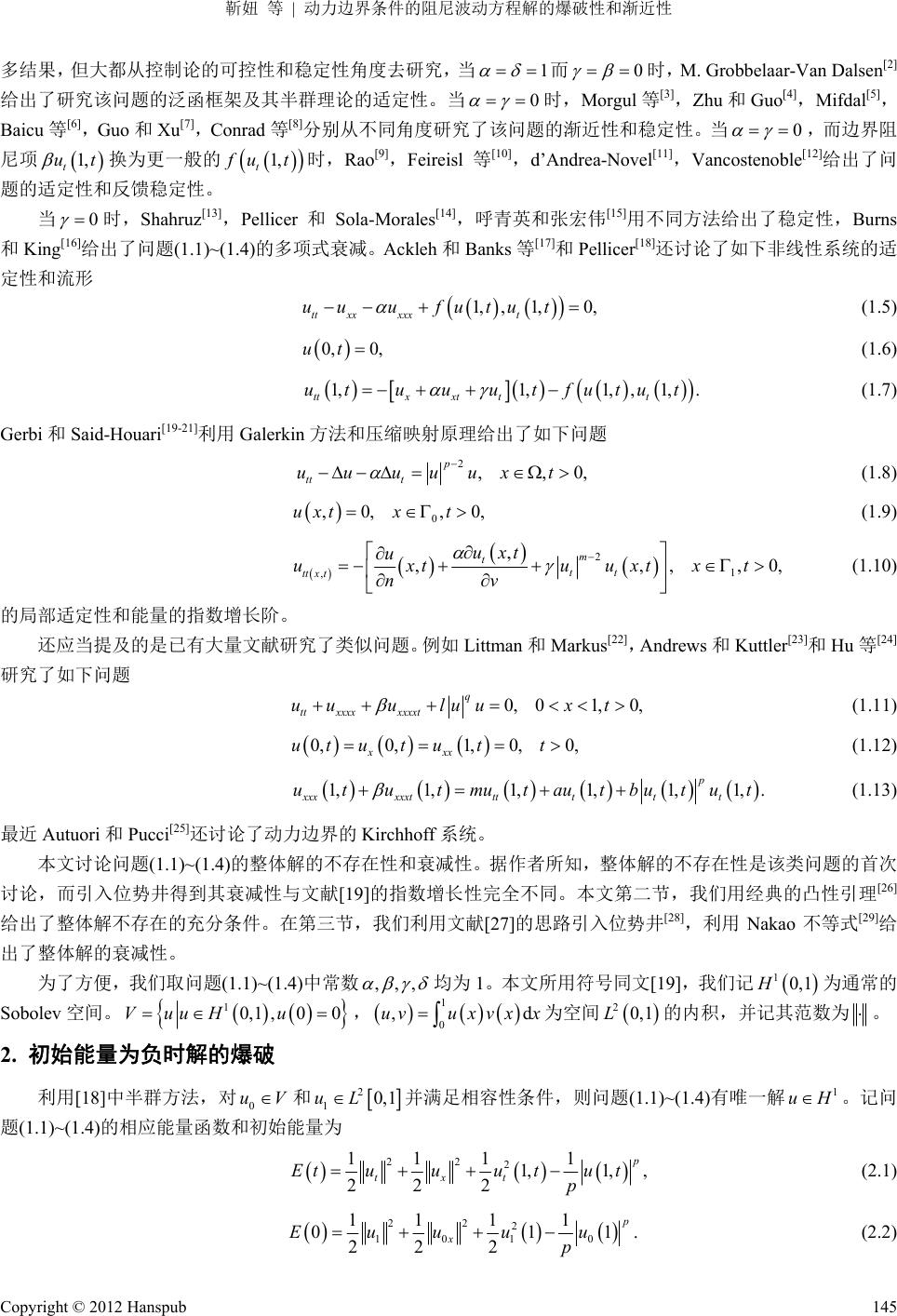 靳妞 等 动力边界条件的阻尼波动方程解的爆破性和渐近性 多结果,但大都从控制论的可控性和稳定性角度去研究,当 1 而0 时,M. Grobbelaar-Van Dalsen[2] 给出了研究该问题的泛函框架及其半群理论的适定性。当 0 时,Morgul 等[3],Zhu 和Guo[4],Mifdal[5], Baicu 等[6],Guo 和Xu[7],Conrad 等[8]分别从不同角度研究了该问题的渐近性和稳定性。当 0 ,而边界阻 尼项 换为更一般的 1, t ut 1, t f ut时,Rao[9],Feireisl 等[10],d’Andrea-Novel[11],Vancostenoble[12]给出了问 题的适定性和反馈稳定性。 当0 时,Shahruz[13],Pellicer 和Sola-Morales[14],呼青英和张宏伟[15]用不同方法给出了稳定性,Burns 和King[16]给出了问题(1.1)~(1.4)的多项式衰减。Ackleh和Banks 等[17]和Pellicer[18]还讨论了如下非线性系统的适 定性和流形 1, ,1,0, tt xxxxxt uuu futut (1.5) 0, 0,ut (1.6) 1,1,1, ,1,. ttxxt tt utu uutfutut (1.7) Gerbi 和Said-Houari[19-21]利用 Galerkin 方法和压缩映射原理给出了如下问题 2,, p tt t uuuuuxt 0, , (1.8) 0 ,0, ,0uxtx t (1.9) 2 1 , , ,,, m ttt ttx t uxt u uxt uuxtx nv ,0,t (1.10) 的局部适定性和能量的指数增长阶。 还应当提及的是已有大量文献研究了类似问题。例如 Littman 和Markus[22],Andrews 和Kuttler[23]和Hu 等[24] 研究了如下问题 0, 01,0, q tt xxxxxxxxt uuuluuxt (1.11) 0,0,1, 0,0, xxx utu tutt (1.12) 1,1,1,1,1,1, . p xxxxxxttttt t ututmutautbutut (1.13) 最近 Autuori和Pucci[25]还讨论了动力边界的 Kirchhoff系统。 本文讨论问题(1.1)~(1.4)的整体解的不存在性和衰减性。据作者所知,整体解的不存在性是该类问题的首次 讨论,而引入位势井得到其衰减性与文献[19]的指数增长性完全不同。本文第二节,我们用经典的凸性引理[26] 给出了整体解不存在的充分条件。在第三节,我们利用文献[27]的思路引入位势井[28],利用 Nakao 不等式[29]给 出了整体解的衰减性。 为了方便,我们取问题(1.1)~(1.4)中常数 ,,, 均为 1。本文所用符号同文[19],我们记 为通常的 Sobolev 空间。 10,1H 10,1 ,00VuuH u , 为空间 uv 1 0 ,du xv xx 20, 1L的内积,并记其范数为 。 2. 初始能量为负时解的爆破 利用[18]中半群方法,对 和 0 uV 2 10,1uL并满足相容性条件,则问题(1.1)~(1.4)有唯一解 。记问 题(1.1)~(1.4) 的相应能量函数和初始能量为 1 uH 22 2 111 1 1, 1, 222 p txt Etuuutu t p , (2.1) 22 2 101 0 111 1 01 22 21 p x Euuuu p . (2.2) Copyright © 2012 Hanspub 145  靳妞 等 动力边界条件的阻尼波动方程解的爆破性和渐近性 从而有 221, dxt t dEtuu t t . (2.3) 因此有 22 00 0d1, tt xs s EtEusus s d. (2.4) 引理 2.1[26] 设 H t是 上的非负二次连续可导函数,且满足, 0,R 0 2 10HtHt Ht 为常数。若 ,,则必存在时刻 00H 00H 1 0 0 H TT H 使当 时有。 tT Ht 其中 定理 2.2 设问题(1.1)~(1.4)存在局部解, ,2p 00E ,则必存在有限时刻 T,使问题(1.1)~(1.4)的解爆 破。 证明 记 2 2 22222 000 0 00 1, dd1,1 tt xx F tu ussusutTtuutt , (2.5) 其中 , 0 T , 为非负常数,并在后面确定,则 0 t 0 00 2,21,1,d 2,d 21,1,2 tt tt xxst F tuuusussuussututtt , (2.6) 22 2 21,1, p txt Ftuuutut . (2.7) 对(2.7)利用 能量等 式(2.4)以及 有 2p 22 22 0 22 00 21,d1,d 2 202d21,d tt ttxs sx o tt xs s 2 F tpuutususspu pEp uspuss . (2.8) 取并注意到 ,则(2.8)可写成 02E 02p 2 222 00 21,d1,d tt ttxs s Ftpuu tususs . (2.9) 又由 不等式知, Holder 2 11 11 22 22 222 22 22 0 00 00 41,d1,ddd1,1, tt tt ttxxst Ftuuu ssu ssususututtt (2.10) 则由(2.6),(2.9),(2.10)以及 Cauchy-Schwartz 不等式得 2 20 4 p FtFtF t 。又取 充分大,使 0 t 010 10 02,21120Fuuuut 。又注意到 00F,则由引理 2.1知,必存在有限时刻 使问题 (1.1)~(1.4)的解在有限时刻爆破。 1 T 3. 解的衰减估计 记 1 00 inf , 1 x uv u Cu (3.1) 2 00 , p C p 2 00 11 . 2 Ep Copyright © 2012 Hanspub 146 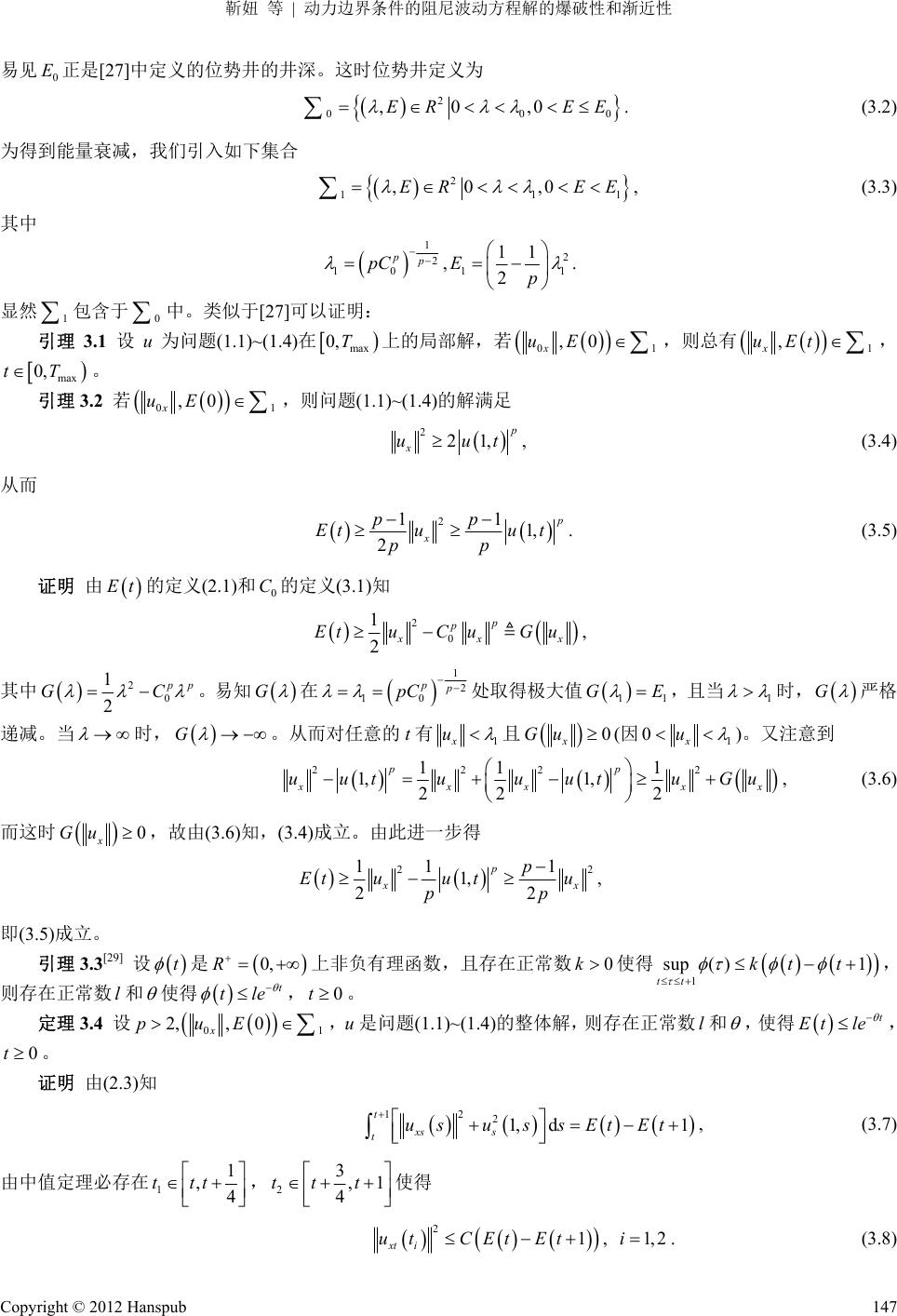 靳妞 等 动力边界条件的阻尼波动方程解的爆破性和渐近性 易见 正是[27]中定义的位势井的井深。这时位势井定义为 0 E 2 00 ,0,0ER EE 0 . (3.2) 为得到能量衰减,我们引入如下集合 2 11 ,0,0ER EE 1 , (3.3) 其中 12 2 10 1 11 ,2 pp pC Ep1 . 显然 包含于中。类似于[27]可以证明: 1 0 引理 3.1 设u为问题(1.1)~(1.4)在 max 0,T上的局部解,若 01 ,0 x uE ,则总有 1 , x uEt , 。 max 0,tT 引理 3.2 若 0 ,0 x uE 1 ,则问题(1.1)~(1.4)的解满足 221, p x uut, (3.4) 从而 2 11 1, 2 p x pp Etuu t pp . (3.5) 证明 由 的定义(2.1)和 的定义(3.1 )知 Et 0 C 2 0 1 2 p p xx EtuCuG u x , 其中 20 1 2 p p GC 。易知 G 在 1 2 10 pp pC 处取得极大值 1 G 1 E ,且当 1 时, G 严格 递减。当 时,。从而对任意的 t有 G 1x u 且 0 x Gu (因1 0x u )。又注意到 222 2 11 1 1, 1, 22 2 pp xxx x uutuuutuGu x , (3.6) 而这时 0 x Gu ,故由(3.6)知,(3.4)成立。由此进一步得 22 11 1 1, 22 p xx p Etuu tu pp , 即(3.5)成立 。 引理 3.3[29] 设 t 是上非负有理函数,且存在正常数 使得 0,R 0k 1 sup( )1 tt kt t , 则存在正常数 和 l 使得 t tle t, 。 0 定理 3.4 设 0 2,, 0 x puE1 ,u是问题(1.1)~(1.4)的整体解,则存在正常数 l和 ,使得 Etle t , 。 0t 证明 由(2.3)知 1221,d1 t xs s tusus sEtEt , (3.7) 由中值定理必存在 11 ,4 ttt ,23,1 4 ttt 使得 21 xt i utCEt Et, 1, 2i . (3.8) Copyright © 2012 Hanspub 147  靳妞 等 动力边界条件的阻尼波动方程解的爆破性和渐近性 这里以及后面的 C表示不同的正常数,但均不依赖于 t。 方程(1.1)两边同乘 u,并在 12 ,0,tt 1上积分得 2 1 22 11 2 2 1 22 1, d1,1, 1, d1,1,d tp xtiiti ti tt sssx xs tt uuss utututut uuss usususus i s . (3.9) 下面估计(3.9)右边的各项。因为 0,0,0 t utu t 。则 , x uCu t uCuxt . (3.10) 由(3.8),(3.10) ,(3.5)和关于t的递减性及 Youn 不等式知 Et g 1 22 2 2 111 1 11 tiixti xixi ii i I ututututCEtEtutCEtEtEt , (3.11) 其中 为任意的正常数,并在后面确定, C 为依赖于 的正常数,注意到 2 1 22 0 1,0,, d1 t txtxt ututuxtxCutCEtEt , (3.12) 2 1 2 0 1,0,, d xx utu tuxtxCutCEt 2 , (3.13) 则由 不等式得, Young 11 222 21 1, 1,11 iti i I ututCEtEt EtCEt EtEt . (3.14) 由(3.7)和(3.10) ,易知 22 11 22 22 31, d1, d1 tt ssxss tt IuussCuussCEtEt . (3.15) 利用(3.7),(3.13) ,的单调递减性和 Youn 不等式有 Et g 22 11 22 41,1,d1,1,d1 tt ss tt I usussu sCu ssCEtEtEt . (3.16) 再由 不等式和(3.7)及Young Et的单调递减性知 2 1 5d1 t xxs t I u sussCEtEtEt . (3.17) 把(3.11),(3.14)~(3.17)代入到(3.9)知 2 1 21,d1 tp x tuussCEtEt E t . (3.18) 另一方面,由引理 3.2 的(3.5) 22 22 2 2 1112111 1, 1,1,1, 1, 22222222 ppp xtt xtt pp Etuutu ututuutuutEt pp 2 1 移项并整理得 222 22 11 1,1, 1,1, pp xttxt pp Etuutuut uutuu pp 2 t t , (3.19) (3.19)式关于t在 12 ,tt 上积分后再利用(3.15)和(3.18)及 Et的单调性得 Copyright © 2012 Hanspub 148  靳妞 等 动力边界条件的阻尼波动方程解的爆破性和渐近性 22 2 11 1 22 2 1 d1,d1,d 11sup tt t p xss tt t tst Es suussuuss C EtEtEtC EtEtEs , (3.20) 因 单调减,可取到 Et 312 ,ttt使 2 1 3d t t EtCEs s, 则由于和 的单调性及(3.7)有 31tt Et 2 1 11 22 22 3 122 11,d d1,d tt xs sxs s tt tt xs s tt Et Etuus sEtuus s CEssuus s 1,d . (3.21) 由 的单调性,(3.20)和(3.7)有 Et 11 sup sup11 tst tst EsEsCEt Et . 取 充分小,则 1 sup 1 tstEsCEt Et 由引理 3.3 得结论。 4. 初始能量为正时解的爆破 本节给出初始能量为正时解爆破的充分条件。 引理 4.1 设 ,2p00x u 且,则必有 0 0EE 22 0x u , 0 Et E , 其中 0 , 同第三节。 0 E 证明 由的单调性知,成立。类似于引理 3.2 的证明,我们有 Et 0 0Et EE 22 0 111 1, 22 p pp xxx c Etuutuugu pp x , (4.1) 其中 20 1 2 p p C gp ,0 。易知 g 在2 00 p p C 处取得极大值 00 g E ,且当 0 时 g 严 格递减,当 时, 。因 g 0 0EE ,则必存在 20 使得 20gE 。由 g 的单调性,若 有 使 0gE 2 g ,则必有 2 。由此我们断言对必有 0t 2x u . (4.2) 事实上,若存在某一时刻 使 00t 0x ut 2 . (4.3) 由于 20 , x ut关于 t连续,由假设应有 0x ut 。但利用(4.1 )及 g 关于 0 时的单调递减性和(4.3) 知 02 0 xo Etg utgE , 此与 0Et E矛盾。因此,(4.2)成立。进一步有结论成立。 Copyright © 2012 Hanspub 149 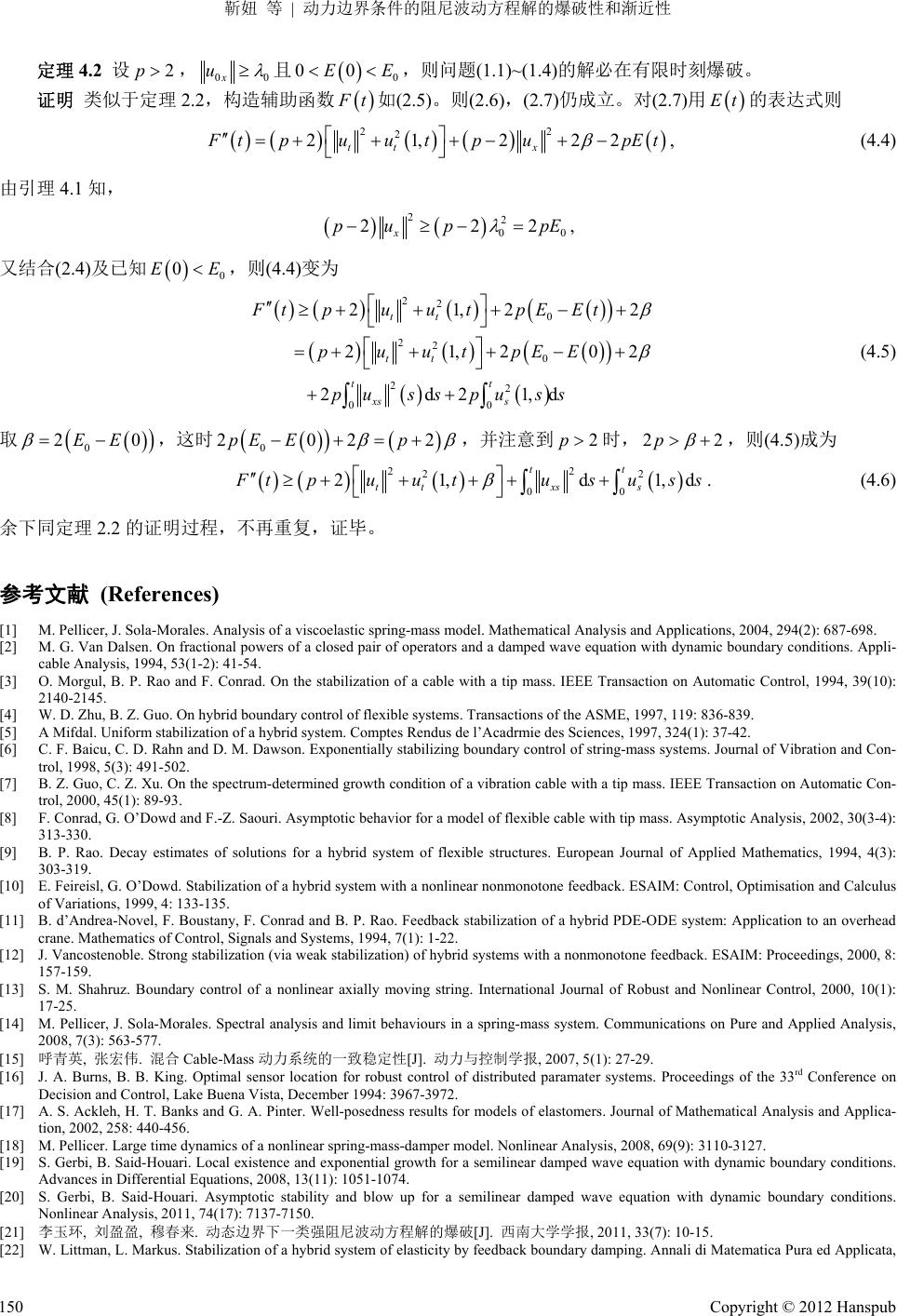 靳妞 等 动力边界条件的阻尼波动方程解的爆破性和渐近性 定理 4.2 设 ,2p00x u 且 ,则问题(1.1)~(1.4)的解必在有限时刻爆破。 0 00EE 证明 类似于定理 2.2,构造辅助函数 F t如(2.5)。则(2.6),(2.7) 仍成立。对 (2.7 )用 的表达式则 Et 22 2 21,222 tt x F tpuutp upEt , (4.4) 由引理 4.1 知, 22 00 22 x pu ppE 2 E , 又结合(2.4)及已知 ,则(4.4)变为 0 0E 220 220 22 00 21,2 21,202 2d21,d tt tt tt xs s FtpuutpE Et puutpEE pusspuss 2 (4.5) 取 ,这时 0 2EE 0 0 202pEEp 2 ,并注意到 时, 2p2p2 ,则(4.5)成为 22 2 00 21,d1, tt ttxss 2 d F tp uutusus s. (4.6) 余下同定理 2.2 的证明过程,不再重复,证毕。 参考文献 (References) [1] M. Pellicer, J. Sola-Morales. Analysis of a viscoelastic spring-mass model. Mathematical Analysis and Applications, 2004, 294(2): 687-698. [2] M. G. Van Dalsen. On fractional powers of a closed pair of operators and a damped wave equation with dynamic boundary conditions. Appli- cable Analysis, 1994, 53(1-2): 41-54. [3] O. Morgul, B. P. Rao and F. Conrad. On the stabilization of a cable with a tip mass. IEEE Transaction on Automatic Control, 1994, 39(10): 2140-2145. [4] W. D. Zhu, B. Z. Guo. On hybrid boundary control of flexible systems. Transactions of the ASME, 1997, 119: 836-839. [5] A Mifdal. Uniform stabilization of a hybrid system. Comptes Rendus de l’Acadrmie des Sciences, 1997, 324(1): 37-42. [6] C. F. Baicu, C. D. Rahn and D. M. Dawson. Exponentially stabilizing boundary control of string-mass systems. Journal of Vibration and Con- trol, 1998, 5(3): 491-502. [7] B. Z. Guo, C. Z. Xu. On the spectrum-determined growth condition of a vibration cable with a tip mass. IEEE Transaction on Automatic Con- trol, 2000, 45(1): 89-93. [8] F. Conrad, G. O’Dowd and F.-Z. Saouri. Asymptotic behavior for a model of flexible cable with tip mass. Asymptotic Analysis, 2002, 30(3-4): 313-330. [9] B. P. Rao. Decay estimates of solutions for a hybrid system of flexible structures. European Journal of Applied Mathematics, 1994, 4(3): 303-319. [10] E. Feireisl, G. O’Dowd. Stabilization of a hybrid system with a nonlinear nonmonotone feedback. ESAIM: Control, Optimisation and Calculus of Variations, 1999, 4: 133-135. [11] B. d’Andrea-Novel, F. Boustany, F. Conrad and B. P. Rao. Feedback stabilization of a hybrid PDE-ODE syste m: Application to an overhead crane. Mathematics of Control, Signals and Systems, 1994, 7(1): 1-22. [12] J. Vancostenoble. Strong stabilization (via weak stabilization) of hybrid systems with a nonmonotone feedback. ESAIM: Proceedings, 2000, 8: 157-159. [13] S. M. Shahruz. Boundary control of a nonlinear axially moving string. International Journal of Robust and Nonlinear Control, 2000, 10(1): 17-25. [14] M. Pellicer, J. Sola-Morales. Spectral analysis and limit behaviours in a spring-mass system. Communications on Pure and Applied Analysis, 2008, 7(3): 563-577. [15] 呼青英, 张宏伟. 混合 Cable-Mass 动力系统的一致稳定性[J]. 动力与控制学报, 2007, 5(1): 27-29. [16] J. A. Burns, B. B. King. Optimal sensor location for robust control of distributed paramater systems. Proceedings of the 33rd Conference on Decision and Control, Lake Buena Vista, December 1994: 3967-3972. [17] A. S. Ackleh, H. T. Banks and G. A. Pinter. Well-posedness results for models of elastomers. Journal of Mathematical Analysis and Applica- tion, 2002, 258: 440-456. [18] M. Pellicer. Large time dynamics of a nonlinear spring-mass-damper model. Nonlinear Analysis, 2008, 69(9): 3110-3127. [19] S. Gerbi, B. Said-Houari. Local existence and exponential growth for a semilinear damped wave equation with dynamic boundary conditions. Advances in Differential Equations, 2008, 13(11): 1051-1074. [20] S. Gerbi, B. Said-Houari. Asymptotic stability and blow up for a semilinear damped wave equation with dynamic boundary conditions. Nonlinear Analysis, 2011, 74(17): 7137-7150. [21] 李玉环, 刘盈盈, 穆春来. 动态边界下一类强阻尼波动方程解的爆破[J]. 西南大学学报, 2011, 33(7): 10-15. [22] W. Littman, L. Markus. Stabilization of a hybrid system of elasticity by feedback boundary damping. Annali di Matematica Pura ed Applicata, Copyright © 2012 Hanspub 150 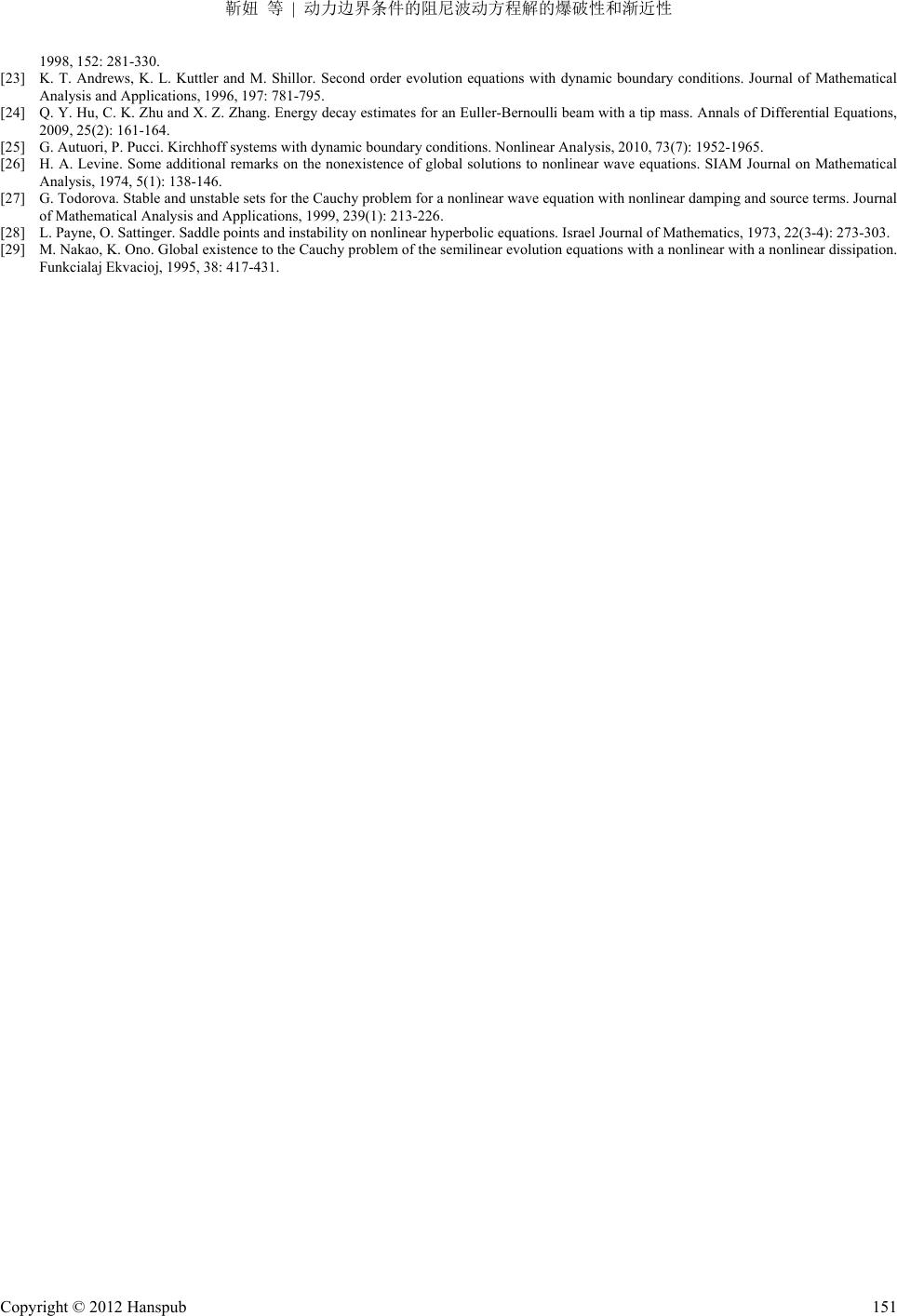 靳妞 等 动力边界条件的阻尼波动方程解的爆破性和渐近性 Copyright © 2012 Hanspub 151 1998, 152: 281-330. [23] K. T. Andrews, K. L. Kuttler and M. Shillor. Second order evolution equations with dynamic boundary conditions. Journal of Mathematical Analysis and Applications, 1996, 197: 781-795. [24] Q. Y. Hu, C. K. Zhu and X. Z. Zhang. Energy decay estimates for an Euller-Bernoulli beam with a tip mass. Annals of Differential Equations, 2009, 25(2): 161-164. [25] G. Autuori, P. Pucci. Kirchhoff systems with dynamic boundary conditions. Nonlinear Analysis, 2010, 73(7): 1952-1965. [26] H. A. Levine. Some additional remarks on the nonexistence of global solutions to nonlinear wave equations. SIAM Journal on Mathematical Analysis, 1974, 5(1): 138-146. [27] G. Todorova. Stable and unstable sets for the Cauchy problem for a nonlinear wave equation with nonlinear damping and source terms. Journal of Mathematical Analysis and Applications, 1999, 239(1): 213-226. [28] L. Payne, O. Sattinger. Saddle points and instability on nonlinear hyperbolic equations. Israel Journal of Mathematics, 1973, 22(3-4): 273-303. [29] M. Nakao, K. Ono. Global existence to the Cauchy problem of the semilinear evolution equations with a nonlinear with a nonlinear dissipation. Funkcialaj Ekvacioj, 1995, 38: 417-431. |